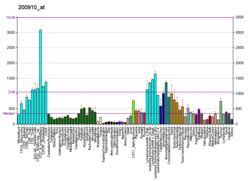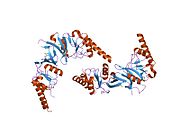CCT3
Jump to navigation
Jump to search
T-complex protein 1 subunit gamma is a protein that in humans is encoded by the CCT3 gene.[5][6]
Function
This gene encodes a molecular chaperone that is member of the TRiC complex. This complex consists of two identical stacked rings, each containing eight different proteins. Unfolded polypeptides enter the central cavity of the complex and are folded in an ATP-dependent manner. The complex folds various proteins, including actin and tubulin. Alternate transcriptional splice variants, encoding different isoforms, have been characterized.[6]
Interactions
CCT3 has been shown to interact with PPP4C.[7][8]
References
- ^ a b c GRCh38: Ensembl release 89: ENSG00000163468 – Ensembl, May 2017
- ^ a b c GRCm38: Ensembl release 89: ENSMUSG00000001416 – Ensembl, May 2017
- ^ "Human PubMed Reference:". National Center for Biotechnology Information, U.S. National Library of Medicine.
- ^ "Mouse PubMed Reference:". National Center for Biotechnology Information, U.S. National Library of Medicine.
- ^ Joly EC, Sévigny G, Todorov IT, Bibor-Hardy V (Mar 1994). "cDNA encoding a novel TCP1-related protein". Biochimica et Biophysica Acta (BBA) - Gene Structure and Expression. 1217 (2): 224–6. doi:10.1016/0167-4781(94)90041-8. PMID 8110840.
- ^ a b "Entrez Gene: CCT3 chaperonin containing TCP1, subunit 3 (gamma)".
- ^ Chen GI, Tisayakorn S, Jorgensen C, D'Ambrosio LM, Goudreault M, Gingras AC (Oct 2008). "PP4R4/KIAA1622 forms a novel stable cytosolic complex with phosphoprotein phosphatase 4". The Journal of Biological Chemistry. 283 (43): 29273–84. doi:10.1074/jbc.M803443200. PMC 2662017. PMID 18715871.
- ^ Gingras AC, Caballero M, Zarske M, Sanchez A, Hazbun TR, Fields S, Sonenberg N, Hafen E, Raught B, Aebersold R (Nov 2005). "A novel, evolutionarily conserved protein phosphatase complex involved in cisplatin sensitivity". Molecular & Cellular Proteomics. 4 (11): 1725–40. doi:10.1074/mcp.M500231-MCP200. PMID 16085932.
External links
- Human CCT3 genome location and CCT3 gene details page in the UCSC Genome Browser.
Further reading
- Kubota H, Hynes G, Carne A, Ashworth A, Willison K (Feb 1994). "Identification of six Tcp-1-related genes encoding divergent subunits of the TCP-1-containing chaperonin". Current Biology. 4 (2): 89–99. Bibcode:1994CBio....4...89K. doi:10.1016/S0960-9822(94)00024-2. PMID 7953530. S2CID 31300131.
- Sévigny G, Joly EC, Bibor-Hardy V, Lemieux N (Aug 1994). "Assignment of the human homologue of the mTRiC-P5 gene (TRIC5) to band 1q23 by fluorescence in situ hybridization". Genomics. 22 (3): 634–6. doi:10.1006/geno.1994.1438. PMID 8001976.
- Walkley NA, Demaine AG, Malik AN (Jan 1996). "Cloning, structure and mRNA expression of human Cctg, which encodes the chaperonin subunit CCT gamma". The Biochemical Journal. 313 (Pt 2): 381–9. doi:10.1042/bj3130381. PMC 1216920. PMID 8573069.
- Feldman DE, Thulasiraman V, Ferreyra RG, Frydman J (Dec 1999). "Formation of the VHL-elongin BC tumor suppressor complex is mediated by the chaperonin TRiC". Molecular Cell. 4 (6): 1051–61. doi:10.1016/S1097-2765(00)80233-6. PMID 10635329.
- Wong N, Chan A, Lee SW, Lam E, To KF, Lai PB, Li XN, Liew CT, Johnson PJ (Mar 2003). "Positional mapping for amplified DNA sequences on 1q21-q22 in hepatocellular carcinoma indicates candidate genes over-expression". Journal of Hepatology. 38 (3): 298–306. doi:10.1016/S0168-8278(02)00412-9. PMID 12586295.
- Yuryev A, Wennogle LP (Feb 2003). "Novel raf kinase protein-protein interactions found by an exhaustive yeast two-hybrid analysis". Genomics. 81 (2): 112–25. doi:10.1016/S0888-7543(02)00008-3. PMID 12620389.
- Reuter TY, Medhurst AL, Waisfisz Q, Zhi Y, Herterich S, Hoehn H, Gross HJ, Joenje H, Hoatlin ME, Mathew CG, Huber PA (Oct 2003). "Yeast two-hybrid screens imply involvement of Fanconi anemia proteins in transcription regulation, cell signaling, oxidative metabolism, and cellular transport". Experimental Cell Research. 289 (2): 211–21. doi:10.1016/S0014-4827(03)00261-1. PMID 14499622.
- Imai Y, Soda M, Murakami T, Shoji M, Abe K, Takahashi R (Dec 2003). "A product of the human gene adjacent to parkin is a component of Lewy bodies and suppresses Pael receptor-induced cell death". The Journal of Biological Chemistry. 278 (51): 51901–10. doi:10.1074/jbc.M309655200. PMID 14532270.
- Rual JF, Venkatesan K, Hao T, Hirozane-Kishikawa T, Dricot A, Li N, Berriz GF, Gibbons FD, Dreze M, Ayivi-Guedehoussou N, Klitgord N, Simon C, Boxem M, Milstein S, Rosenberg J, Goldberg DS, Zhang LV, Wong SL, Franklin G, Li S, Albala JS, Lim J, Fraughton C, Llamosas E, Cevik S, Bex C, Lamesch P, Sikorski RS, Vandenhaute J, Zoghbi HY, Smolyar A, Bosak S, Sequerra R, Doucette-Stamm L, Cusick ME, Hill DE, Roth FP, Vidal M (Oct 2005). "Towards a proteome-scale map of the human protein-protein interaction network". Nature. 437 (7062): 1173–8. Bibcode:2005Natur.437.1173R. doi:10.1038/nature04209. PMID 16189514. S2CID 4427026.







